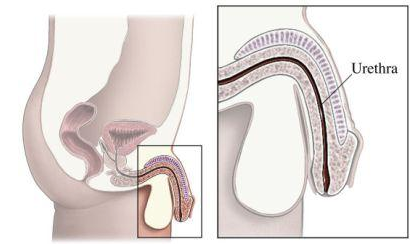Definition
Direct vision internal urethrotomy (DVIU) is surgery to repair a narrowed section of the urethra. This is referred to as a stricture. The urethra is the tube through which urine passes from the bladder to the outside of the body.
Reasons for Procedure
Urethral stricture is due to scarring of the urethra. This scarring may be caused by infection or injury. DVIU cuts through the scar tissue and opens the urethra.
Urethral stricture can result in:
- Prostate problems in men
- Infections of the bladder or kidneys
- Inability to urinate or empty the bladder completely
Possible Complications
Problems from the procedure are rare, but all procedures have some risk. Your doctor will review potential problems, like:
- Reaction to anesthesia
- Excessive bleeding
- Blood clots
- Infection
- Pain when urinating
- Damage to urethra
- Recurrent stricture
- Need for more procedures
- Penis pain
- Erectile dysfunction
Factors that may increase the risk of complications include:
- Bleeding disorders or taking medications that reduce blood clotting
- Obesity
- Smoking
Discuss these risks with your doctor before the procedure.
What to Expect
Prior to Procedure
Your doctor may do the following:
- Conduct a physical exam and ask about your medical history
- Order imaging, blood, and urine tests
- Talk about the anesthesia being used and its potential risks
Talk to your doctor about your medications. You may be asked to stop taking some medications up to 10 days before the procedure.
In the days leading up to the procedure:
- Take a shower before the procedure as directed.
- Arrange for a ride home from the hospital.
- Do not take anything by mouth starting 8 hours before your procedure. Ask the doctor how you should take your regular medications on the morning of your procedure.
Anesthesia
General or spinal anesthesia will be used. It will block any pain and keep you asleep or sedated through the surgery.
Description of the Procedure
After you are asleep, a special tube called a cystoscope will be placed in your urethra to locate the stricture. Next, a special tool will be placed through the cystoscope and used to cut away the scar tissue inside your urethra to make it wider. The scar tissue may be removed by cutting or using a laser or heat source. After the tissue is removed, the urethra and bladder area will be examined.
A catheter may be placed once the surgery is complete. A catheter is a plastic tube place through the urethra into the bladder.
How Long Will It Take?
About 30 minutes
How Much Will It Hurt?
Anesthesia prevents pain during surgery. Ask your doctor about medication to help with the pain.
Average Hospital Stay
You will be able to go home the same day in most cases.
Post-procedure Care
At the Care Center
During recovery immediately after surgery your vital signs will be monitored. Pain medication will be delivered as needed. The catheter will be checked to make sure urine is passing as expected.
You will be encouraged to move around and have some food before leaving.
At Home
A catheter may be left in place once you leave the hospital. The catheter will help urine pass and keep the urethra open while it heals.
Certain physical activities will be limited in the first few weeks such as heavy lifting or sexual activity.
Call Your Doctor
Call your doctor if any of the following occur:
- Increasing pressure or pain
- Catheter does not drain properly
- Difficulty passing urine after catheter is taken out
- Changes in frequency or volume of urine
- Signs of infection, including fever or chills
- Excess blood in urine
If you think you have an emergency, call for emergency medical services right away.

